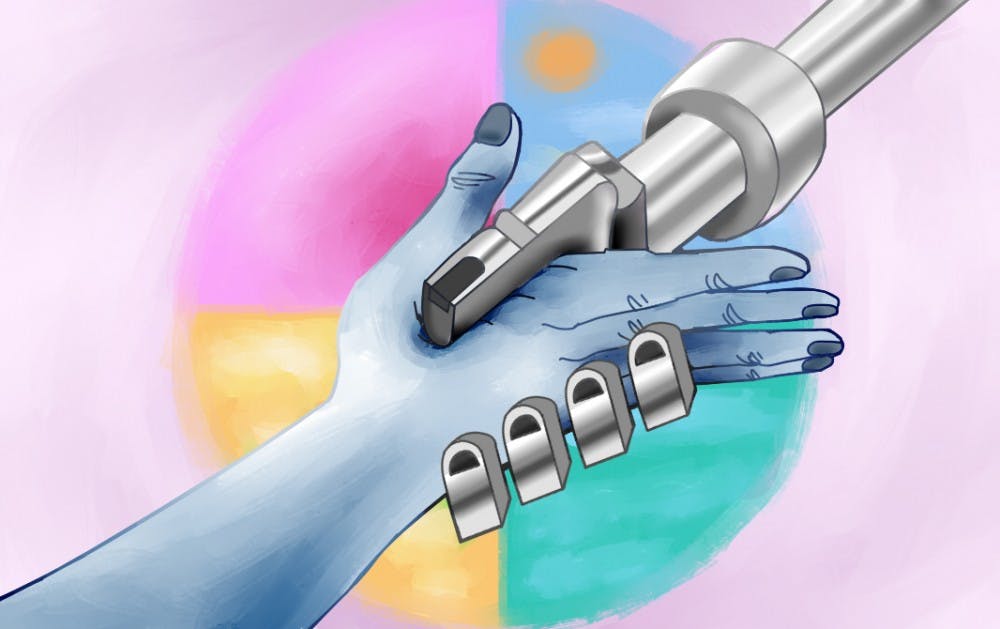Thanks to the efforts of ASU researcher James Abbas along with other researchers across multiple institutions, the first neural-enabled prosthetic hand system has been created.
This prosthetic works similarly to older models, but surpasses their usual capabilities. The NEPH system requires a neural implant in the patient that works with the brain and the machine to produce sensations of touch in the hand.
Abbas, the director of the Center for Adaptive Neural Systems and an associate professor in the School of Biological and Health Systems Engineering, explained that this technology is designed for those who have lost a hand from amputation.
Abbas also said this implant was built off the common experience of phantom limb, when amputees can feel sensations and even phantom pain from a limb that the individual had lost.
“This is a real team effort like any project like this, and most of the team is based at Florida International University,” Abbas said in acknowledgement of his associates leading this effort, such as FIU professor Ranu Jung, a former ASU professor.
The National Institute of Biomedical Imaging and Bioengineering provided funding for the project, Abbas said. Although the project is still in its early stages of development, it has been two years since the Food and Drug Administration has allowed an investigational device exemption for human trials of this device.
Currently, project members are documenting the experiences of Jason Little, the first owner of the NEPH system — and the first person to use this specific technology outside of a lab setting.
“Jason Little has been coming into our lab at Florida International University regularly to undergo testing and for us to set up the system," Abbas said. "But now, for about four months, he has the system at home and uses it as he pleases.”
Little’s successful implant surgery and his use of the prosthetic at home is a huge step for Abbas and the team, but it is only the first of a long journey until this product can be widely available to amputees.
“It takes a while to learn how to use a technology like this," Abbas said. "The brain and the nervous system can adapt to it and you learn new strategies about how to interpret the information and then how to use that (information)."
Abbas said that the FDA exemption has given the project approval to test this product on six people, and if those tests are successful, then they can seek further approval from the FDA and continue the development process.
Michael Collins, a lecturer in the College of Health Solutions, said this new technology is unlike any prosthetic technology he’s seen.
“How amazing is it that you can nearly humanize a prosthesis?" Collins said. "If you look back not even that long ago, any mechanical hand looked like two pieces of metal that could just pinch."
This technology is unprecedented and according to Collins, the neural component might help amputees who balk at the idea of using an inhuman hand or alleviate some phantom pain by providing a real source of the feeling.
Abbas also expressed his hopes that this technology could ultimately be used in lower limb amputations and double amputations.
An ASU alumnus and hospital employee, Aaron Cohen, marveled at the innovation of this product.
"The bidirectional system utilized by this prosthetic hand can be applied to allow ... greater restoration of ability to amputees such as prosthetic limbs that allow above the knee amputees to walk with more confidence on unstable surfaces,” Cohen said.
While NEPH technology is currently designed for those who have had an amputation, Cohen cited its hefty costs as a possible limiting factor in the accessibility of the product, which could prevent all amputees from affording the technology.
“I think this technology is a great step for biomedical engineering, but I am concerned about what groups will have access to this technology,” Cohen said.
The prosthetic has not advanced far enough for anyone to purchase, but Abbas’s passion for getting this technology to as many people as possible indicates that every effort will be made by the team to help this prosthetic become widely available.
Reach the reporter at gmlieber@asu.edu or follow @G_Mira_ on Twitter.
Like The State Press on Facebook and follow @statepress on Twitter.




